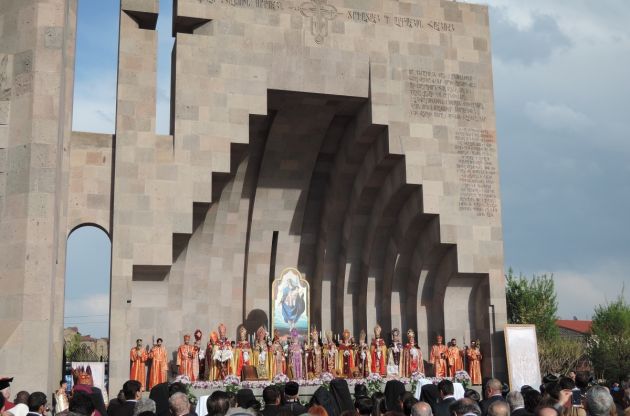Armenians in Nagorno-Karabakh fear Christian religious heritage is endangered

Armenians remembered the 1915 genocide on April 24, but many are concerned about their heritage in Nagorno-Karabakh, which has been held by Azerbaijan since November 2020.
"Armenians fear new war with Azerbaijan despite talk of peace," the BBC headlined a report on April 24.
Since Azerbaijan's invasion of Nagorno-Karabakh in September 2023, the destruction of religious monuments has escalated, La Croix International reports.
The fate of Armenian heritage is now a source of worry for many experts, according to Le Croix, and there are questions if it suffers the same fate as the Armenian heritage in the autonomous republic of Nakhichevan.
Attempts to reclaim or destroy Armenian heritage in Nagorno-Karabakh by Azerbaijan have increased since the forced exodus of its population in September.
Armenians left behind a largely Christian cultural legacy – an official list established during the Soviet era catalogs over 4,000 monuments, many dating from the first half of the Middle Ages.
Among them are 33 monasteries, 252 churches, 83 chapels, 1,840 khachkars (Armenian cross-stones), and 218 cemeteries.
Modern-day Armenia and Azerbaijan became part of the Soviet Union in the 1920s.
CONTROLLED BY AZERBAIJAN
According to the BBC, the area designated Nagorno-Karabakh had a majority ethnic-Armenian population but was controlled by Azerbaijan.
Nagorno-Karabakh's regional parliament voted to become part of Armenia when the Soviet Union began to collapse in the late 1980s.
According to Wikipedia, the two have had strained relations due to the five wars the countries waged over the past century—one from 1918 to 1921, another from 1988 to 1994, and the most recent in 2016, 2020, and 2023.
Armenia is having problems integrating over 100,000 refugees who fled Nagorno-Karabakh when Azerbaijan took control of the enclave in September 2023, the International Crisis Group reported on March 4.
WORRY FOR ARMENIAN HERITAGE
The fate of Armenian heritage is now a source of worry for many experts, according to Le Croix, and there are questions if it suffers the same fate as the Armenian heritage in the autonomous republic of Nakhichevan.
This region, which belonged to Armenia before Sovietization, saw 98% of its heritage sites destroyed by Azerbaijanis between 1997 and 2011, according to a report by Caucasus Heritage Watch, a group of American scholars documenting attacks on Armenian heritage in Nakhichevan and Nagorno-Karabakh.
On April 4, satellite data analysis revealed the destruction of the 19th-century St. John the Baptist Church in the city of Shushi in Nagorno-Karabakh.
The building had already been bombed by Azerbaijan during the 2020 war and has been razed, according to Le Croix.
A church and an entire village have been 'erased' in Azerbaijan's recaptured Nagorno-Karabakh, Radio Free Europe reported on April 24
"One of the important lessons learned from the Nakhchivan case is that total cultural erasure takes time," Khatchadourian told RFE/RL. "The demolition of the Armenian cultural landscape in that region unfolded over a decade, beginning in 1997 and continuing until at least 2009, and possibly as late as 2011."
The researcher says that, in the case of Nagorno-Karabakh, "this sad story is likely to play out over many years."
Images released recently by the monitoring group Caucasus Heritage Watch indicate that the Susa/Shushi church, which was wrapped in scaffolding through much of its time under Azerbaijani control, was demolished in the winter of 2023-2024.
Azerbaijan retook control of Susa/Shushi from ethnic Armenian forces in November 2020 after launching a war to retake territory internationally recognized as Azerbaijani land.
Lori Khatchadourian, an associate professor at Cornell University and the co-founder of Caucasus Heritage Watch says the monitoring group has so far noted the destruction of 10 heritage sites within Azerbaijan's retaken territory since 2020.
SURVEY ON HERITAGE LOCATIONS
The Watch is currently beginning a new survey of hundreds of heritage locations.
She cited the precedent of the virtually complete erasure of Armenian heritage in the Azerbaijani exclave of Nakhchivan as an example of what may lie ahead in Nagorno-Karabakh.
Le Croix outlined a timeline relating to the area:
July 5, 1921. Joseph Stalin decides to attach Armenian Karabakh and Nakhichevan to the Azerbaijan Soviet Socialist Republic.
1991. After the fall of the Soviet Union, Armenia and Azerbaijan declare independence. Karabakh Armenians wish to be annexed to Armenia, leading to a three-year conflict resulting in 30,000 deaths.
September 27, 2020. Azerbaijan attacks the Republic of Nagorno-Karabakh. After 44 days of fighting and over 6,500 casualties, the conflict ends on November 9, 2020.
September 19, 2023. Last Azerbaijani attack. After a day of combat, Nagorno-Karabakh authorities surrender. Exodus of its 120,000 inhabitants.